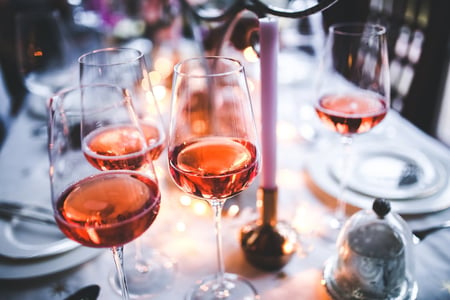Provence is known for their auspicious array of wines. Among those palate pleasing potables, rosé is experiencing quite a renaissance these days. This easy-to-drink libation is as comfortable at a black-tie affair as it is in a picnic basket. Rosé is perfectly paired with the lighter fare of summer and as a complement to charcuterie or a cheese plate. Highly versatile, pleasantly palatable and utterly French, it’s easy to understand the popularity of this consummate Provençal potable.
Not all rosés are produced in France, obviously, however the French do dominate the market in this delicate, drinkable wine. The benchmark of rosé is undoubtedly the Provençal rosé. Provence rosé has all the characteristics of an excellent wine of this variety-it’s crisp, fresh, fruity and dry.
The Perfect Sip of Summer Anytime of Year
A glass of rosé is the perfect way to enjoy a summer evening. Pale with a hint of pink, Provence rosés are made from a blend of Grenache, Syrah, Cinsault and often include Mouvedré. The flavor profile is often described as red currant with a hint of pepper, citrus and underlying minerality.
Provence rosé is more pale than true pink. The light color is owed to the Grenache which has a light colored skin, along with Cinsault, equally light in hue. Once Syrah or sometimes Cabernet Sauvignon are added the color becomes rosier.
What Makes Rosé from Provence Superior?
Obviously the terroir of the Provence region has much to do with the superior rosé they produce. The process of harvesting and pressing the grapes is somewhat complicated but, in the end, quite worth the effort.
In order to get the proper color and flavor profile it's necessary to harvest the grapes at night, when it’s cooler. This prevents oxidation. The light color is achieved by pressing the grapes gently to release the juice.
Rosés make up nearly half of all the wines produced in the Provence region. But it isn’t all about this delicate pink-hued beauty. Some excellent whites and reds also come from Provence.
Modern Appeal But Long History
While millennials may think they brought on the modern trend of enjoying this delightful wine, they’re not quite entirely correct. The recent global popularity of Provençal rosé is deeply rooted in the ancient past.
About 2,600 years ago the Phoenicians, who settled Marseilles, brought grape vines to Provence. The Greeks colonized the region and took over cultivation of the fruit. Through a rudimentary maceration process the Phoenician grapes produced a pink-hued juice. The fermented juice was celebrated throughout the Mediterranean and Provence became the first wine-making region in France. Those early rosés became the country’s oldest wines.
Technology and Tradition
Provençal vineyards today are concerned with technique when it comes to rosé production. More and more vineyards and estates are prioritizing organic farming and biodiversity. The goal is to be entirely organic and embracing biodiversity by 2030.
While the vineyards are preserving a particularly old-school and traditional way of growing the fruit, the wineries are turning to high-tech methods, instead of traditional barrel-maturation, to produce a superior and affordable product. However, some wineries do still prefer barrel maturation to develop more complex rosés.
What Makes Rosé from Provence So Popular?
With any trend it’s difficult to really put your finger on the pulse of why something takes off like it does. The extreme popularity of Provençal rosé over the last two decades is a fine example.
Some factors that make rosés from France’s oldest wine region so desirable? Rosé is relatively low in alcohol and easy to drink, dry with a lively light flavor profile which makes it the perfect wine for today’s array of popular cuisines, and it’s pretty. Another reason more and more people are finding a deep appreciation for rosés from Provence? The feeling of luxury that accompanies anything from the South of France.
Escape to Paradise
The next time you’re craving an escape to the alluring region of Provence, to be kissed by the Mistral and warmed by the sun as it dips below the lavender fields, uncork a chilled bottle of truly delicious Provençal rosé and sip paradise.
Share this article
-
Share on Facebook
Share on Facebook
-
Share on Twitter
Share on Twitter
-
Share on WhatsApp
Share on WhatsApp
-
Share on Pinterest
Share on Pinterest
-
Share on LinkedIn
Share on LinkedIn
-
Share on Tumblr
Share on Tumblr
-
Share on Vk
Share on Vk
-
Share on Reddit
Share on Reddit
-
Share by Mail
Share by Mail



